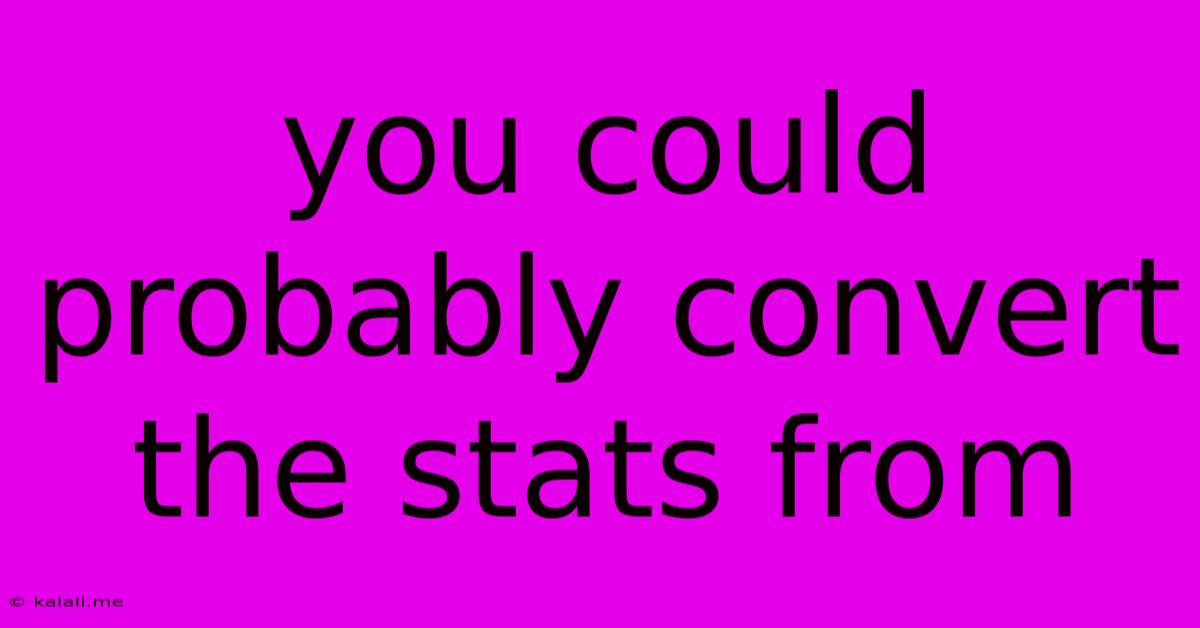You Could Probably Convert The Stats From
Kalali
Jun 05, 2025 · 3 min read

Table of Contents
You Could Probably Convert the Stats From… Unlocking the Power of Data Transformation
Data is everywhere. But raw data is just that – raw. To truly unlock its potential, you need to transform it. This article explores the importance of data conversion and provides practical examples and techniques to help you effectively leverage your statistical information. Understanding how to convert your statistics unlocks valuable insights and allows for more powerful analysis.
This article will cover various methods and scenarios related to data conversion. We'll look at why it's crucial, how to choose the right approach, and address common challenges. By the end, you'll be equipped to confidently convert your own stats and glean meaningful conclusions.
Why Convert Your Stats?
Converting your stats isn't just about changing formats; it's about making your data usable and insightful. Raw data often resides in incompatible formats, hindering analysis and comparison. Conversion allows you to:
- Integrate data from different sources: Combine information from various platforms and databases for a holistic view.
- Improve data quality: Clean and standardize your data, eliminating inconsistencies and errors.
- Enable efficient analysis: Prepare data for specific software or tools, streamlining your workflow.
- Visualize data effectively: Present your findings clearly and concisely through charts and graphs.
- Make data-driven decisions: Gain actionable insights by transforming raw figures into meaningful trends.
Common Data Conversion Scenarios and Techniques
Here are some common situations where data conversion proves essential and the techniques used to accomplish them:
-
CSV to JSON: Converting data from a Comma Separated Value (CSV) file, often used for spreadsheets, to JavaScript Object Notation (JSON), a widely used format for web applications. This involves using scripting languages like Python or dedicated conversion tools.
-
Excel to SQL Database: Transferring data from an Excel spreadsheet to a structured database like MySQL or PostgreSQL. This often involves using database management tools or programming languages to import and structure the data appropriately.
-
Units of Measurement Conversion: Changing units from metric to imperial (or vice-versa) – for example, converting kilometers to miles or Celsius to Fahrenheit. This is usually achieved through simple mathematical formulas applied programmatically.
-
Data Type Conversion: Changing the data type of a variable, such as converting a string to a number or a date to a timestamp. This is often necessary for compatibility with analysis tools and to ensure data integrity.
-
Data Normalization: Transforming data to reduce redundancy and improve data consistency. This is crucial for database design and analysis. Techniques include first, second, and third normal forms.
-
Data Aggregation: Combining multiple data points into summary statistics, like calculating averages, sums, or counts. This process simplifies data for easier interpretation.
Choosing the Right Conversion Method
The best method for data conversion depends heavily on several factors:
- Source and target formats: The formats of your original data and the desired output format will dictate the tools and techniques you employ.
- Data volume: For large datasets, efficient and automated methods are crucial.
- Data complexity: The structure and relationships within your data will influence your approach.
- Available tools and resources: You may need specific software, libraries, or programming expertise depending on the complexity of the task.
Remember to always validate your converted data to ensure accuracy and consistency. Compare the converted data with the original to identify any errors or discrepancies.
Conclusion
Converting your statistics is a fundamental step in the data analysis process. By mastering various conversion techniques and selecting the appropriate methods, you can transform raw data into valuable insights, leading to better decision-making and a deeper understanding of your data. Embrace the power of data transformation and unlock the full potential of your information.
Latest Posts
Latest Posts
-
Moss Grows On What Side Of A Tree
Jun 06, 2025
-
What Do You What Do You
Jun 06, 2025
-
How To Wire Outlet And Light Switch
Jun 06, 2025
-
Why Did Kaneki Hair Turn White
Jun 06, 2025
-
Ora 29913 Error In Executing Odciexttablefetch Callout
Jun 06, 2025
Related Post
Thank you for visiting our website which covers about You Could Probably Convert The Stats From . We hope the information provided has been useful to you. Feel free to contact us if you have any questions or need further assistance. See you next time and don't miss to bookmark.